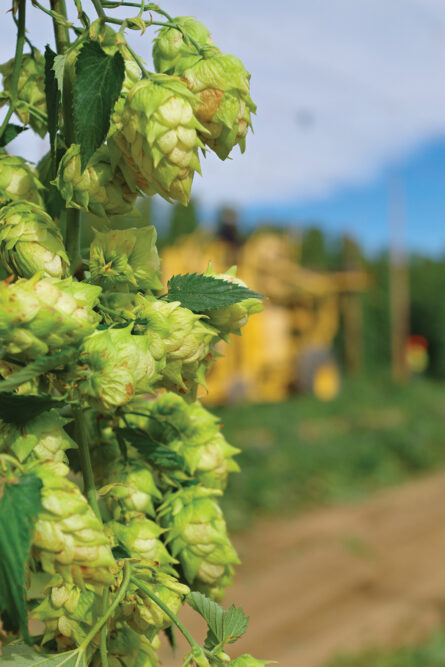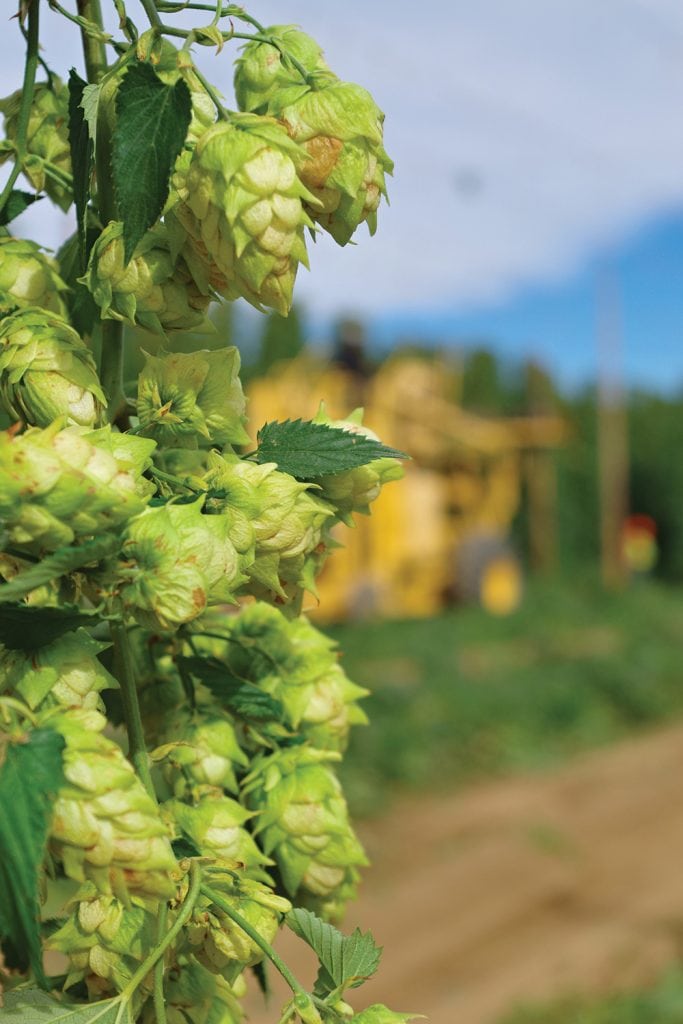
Home » Tops for hops: U.S. dominates world market
Tops for hops: U.S. dominates world market

May 6, 2018
After five years of unprecedented growth, the Northwest hop industry has been almost single-handedly responsible for establishing the U.S. as the No. 1 producer of hops in the world, accounting for 42 percent of all production.
Washington boasts nearly 70 percent of U.S. production, with 98 percent of U.S. hops grown throughout the Northwest, according to the Hop Growers of America’s 2017 report.
But despite the growing popularity of independently-produced beers, the 2018 season will present a drastically different market than the boon that preceded it.
Though craft brew consumption is slowly increasing, demand in current markets has reached saturation, forcing growers in Eastern Washington — the lifeblood of the world’s aroma hop industry — to re-strategize.
Graham Gamache, a fourth-generation hop farmer and owner of Cornerstone Ranches in Toppenish, said he loves growing hops. “I have to though, because it’s been a very volatile industry — it has changed a lot. All of us that are still around — my farm included — have really enjoyed the upturn of the market in the past five to seven years, especially the last three.”
Gamache said the industry is facing an oversupply problem. “Typical of any farmer that’s in commodity, when the market is doing well, we react and we plant,” he said.
The rapid development of the U.S. hop market and stiff competition internationally has led to several adaptive evolutions within the industry in the past few years. As a result, the U.S. began to outproduce Germany in 2015, setting new record production highs year over year through the 2017 season.
A record-breaking 104 million pounds of hops were produced last year in the Northwest — the first time 100 million pounds have ever been produced in a single season.
U.S. hop acreage has increased 79.5 percent since 2012 with production up by 77 percent. From 2016-17, the crop yield jumped 14 percent, thanks to maturing newly-planted hops, and more favorable weather conditions, according to Hop Growers of America.
This growth was aided by a transition to cultivate more aroma varieties — the hops responsible for the unique flavor profiles that characterize craft beer — which coincided with the rise in the popularity of smaller label brews.
Prior to 2010, about half of the hops grown in Washington’s fields were alpha varieties — bittering agents that offset the sugars produced during the brewing process — and sold as commodity crops. Starting in 2012, U.S. farmers began planting more aroma varieties, shifting the balance.
In 2017, U.S. farmers grew 80 percent aroma, or dual-purpose varieties.
Last year also was the first time U.S. growers struggled to sell their surplus harvest on the spot market.
“If you grow more than what’s contracted for, then it’s considered spot. The spot you can normally sell anywhere you want, but it’s immediately exposed to current market conditions,” Gamache said.
He said the spot market is where a saturation point first becomes apparent. Farmers are still getting fair market value for the part of their harvest committed to contracts, but Gamache said in 2017, surplus crops were very difficult to sell, let alone at fair value.
“Three to five years ago, it would have been no problem to get rid of; there was extra demand, and so a good price,” he said.
During the boon years, some growers came to favor the spot market, where the crop could be sold at a premium to buyers who had either underestimated how much they would need and not contracted for enough, or were new to the industry and without a solid network of contracts.
Those growers may face additional hardship in 2018 as they attempt to find a buyer in a market where supply exceeds demand, said Jaki Brophy, communications director for Hop Growers of America.
Industry leaders are recommending growers not add any more acreage this year and contract “cautiously and pragmatically given the unpredictability of craft consumer demand and the recent slowdown of craft volume growth.”

Gamache recalled how between 2009-10, “a lot of my fields were idle, waiting for demand. Hop farmers are used to going lean; it’s happened before, and we would just have to go lean again. But craft is here to stay — it’s continuously changing, but still there.”
Growers may not have to let excess aroma acreage go uncultivated; a Hop Growers of America report said a timely market trend is developing on the international stage where the industry has finally worked through decade-long alpha surpluses, which had depressed the market since 2009.
“Current global alpha inventories are insufficient for market demands,” opening more growing options for Washington hop farmers who, at $10,811 per acre to produce, need that demand to drive a return on investment.
The U.S. switch to a larger focus on aroma varieties a few years ago created a niche in the alpha market for former lead producer Germany to expand into. The renewed market need for alpha hops makes room for the U.S. to capitalize on those varieties once more.
But despite new opportunities, other challenges may become more apparent to hop farmers this season.
Brophy said aroma hops generally present lower yields than alpha varieties, requiring more acreage to obtain the same yields. Though high demand is a good thing, increasing the amount of acreage under cultivation also increases the cost of production.
And even for those looking to convert acreage to alpha, “you don’t get full production for a few years when you plant hops,” Brophy said. “We do get production the first year here and in Idaho … enough to make it worth harvesting,” unlike Oregon and other parts of the country.
She also noted that alpha hops are more of a commodity crop so “the profit margin is very minimal, or at break even,” so farmers will need to budget accordingly when re-organizing field composition.
The increasing cost and scarcity of labor is another factor. Though labor issues are ubiquitous throughout the ag industry, hop growing faces special difficulty.
“It’s intensive,” Brophy said. Specialized equipment puts the poles in the ground, then poles are usually treated to help them last longer, permanent wires must be strung at high tension, support strings that secure structures to the ground must be hand-tied, and the hop plants themselves must be hand-trained.
“There’s no machine available that does the best job,” Brophy said.
But with minimum wage on the rise — $13 to $15 an hour through the federal government’s H-2A temporary farm workers program, up from under $10 an hour just a few years ago, the cost of production keeps rising.
“But the future isn’t all that bleak,” Gamache said. “We’re at the saturation point domestically, but I truly believe — and I think a lot of the other growers and merchants are on the same bandwagon — that there is a burgeoning market internationally. International markets are starting to open up for American craft beer varieties.”
Agriculture + Viticulture
KEYWORDS focus agriculture viticulture 2018




